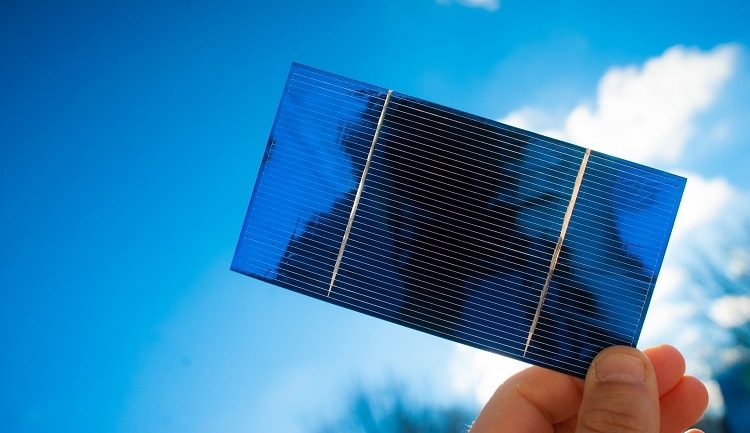
Image Credit:Shutterstock/DaveWeaver
According to the 2017 World Energy Outlook of International Energy Agency, the global energy demand is going to be 30% higher by 2040. The demand is expected to be met by renewable energies with solar power being the cheapest source – thanks to technological advancements and reduced generation costs.
Due to the very promising future of solar power technology, efforts to come up with a more efficient, cheaper and more scalable way to harness energy from the sun are continuously being exerted. One such effort is on the type of material to use in solar cells, with perovskites gaining more attention in recent years because of its potential to generate more electricity than the traditional silicon solar cells.
What are Perovskite Cells?
Perovskite is actually the name given to Calcium Titanate or Calcium Titanium Oxide (CaTiO3), a compound discovered by Gustav Rose in 1839 and was named after Lev Perovski, a Russian mineralogist who first characterized the material. To date, the term “perovskite” refers to all compounds which have the same crystal structure as Calcium Titanate. The structure has a general chemical formula of ABX3, where “A” is an organic cation, “B” is a smaller metal cation, and “X” is an anion that bonds both “A” and “B” cations. For perovskite-based solar cells, the common materials used are: Methylammonium (CH3NH3)+ for “A”; lead (Pb) or tin (Sn) in +2 oxidation state for “B”; and iodide (I−), bromide (Br−) or chloride (Cl−) for “X”.
Perovskite solar cells are being seen as potential replacement for traditional silicon solar cells because of their distinct properties such as high optical absorption coefficient, tunable band gap, low recombination, high open circuit voltage and rapid increase in efficiency. Aside from its properties, perovskites are easy to produce using simple and low-cost fabrication techniques and can be processed on flexible substrates such as plastic or fabric.
How Efficient are Perovskite Cells?
There were several researches and experiments being conducted with regards to the efficiency of perovskite cells. The first record of perovskite cell efficiency was reported by Miyasaka et. al. in 2006. They were able to achieve an efficiency of 3.8% using organometallic perovskite and liquid electrolyte in the hole-transporting material (HTM). The same technique was used by Park et. al. but with enhanced titania surface morphology and perovskite processing. The group was able to increase the efficiency to 6.5%. However, due to the liquid medium, the solar cells were very weak and unstable hence, did not attract much attention.
The adoption of solid-state HTM instead of liquid electrolyte paved the way for higher efficiencies of perovskite cells to be reported. Lee et. al., with >1.1 V open-circuit voltage, attained an efficiency of 10.9% in 2012. Wang et. al., on the other hand, experimented with different materials for their perovskite cells acquiring efficiency of 15.6% in 2013 and 20.1% in 2015.
Just recently, Oxford PV, the leader in the field of perovskite solar technology headquartered in U.K., announced that its 1 cm2 perovskite-silicon tandem solar cell hit a 27.3% conversion efficiency. The achievement was certified by the Fraunhofer Institute for Solar Energy Systems ISE. It is a step towards the company’s goal to go beyond 30% efficiency as what Dr. Chris Case, Chief Technology Officer at Oxford PV said, “We are continuing to push our perovskite-silicon solar cell technology with a roadmap that extends beyond 30% efficiency, driving the world towards an all-electric future”.
With the rapidly increasing efficiency of perovskite cells, it is clear that it can rival that of silicon solar cells or may even replace them in the future.
Are Perovskite Cells Ready for Commercial Use?
There are still challenges, however, that need to be addressed for perovskite cells to be out in the market, specifically its instability and toxicity. Efficiency of perovskite cells drops when exposed to moisture, oxygen, UV radiation and certain temperature levels. To avoid degradation and decomposition, perovskite cells are usually processed inside a glove box to control the environment. The toxicity of perovskite cells, on the other hand, comes from lead (Pb) in which most high efficiency cells are based. Large-scale production of perovskite cells are hindered by above concerns. Once addressed, perovskite cells will play a major role in the solar cell market.
Sources
Disclaimer: The views expressed here are those of the author expressed in their private capacity and do not necessarily represent the views of AZoM.com Limited T/A AZoNetwork the owner and operator of this website. This disclaimer forms part of the Terms and conditions of use of this website.